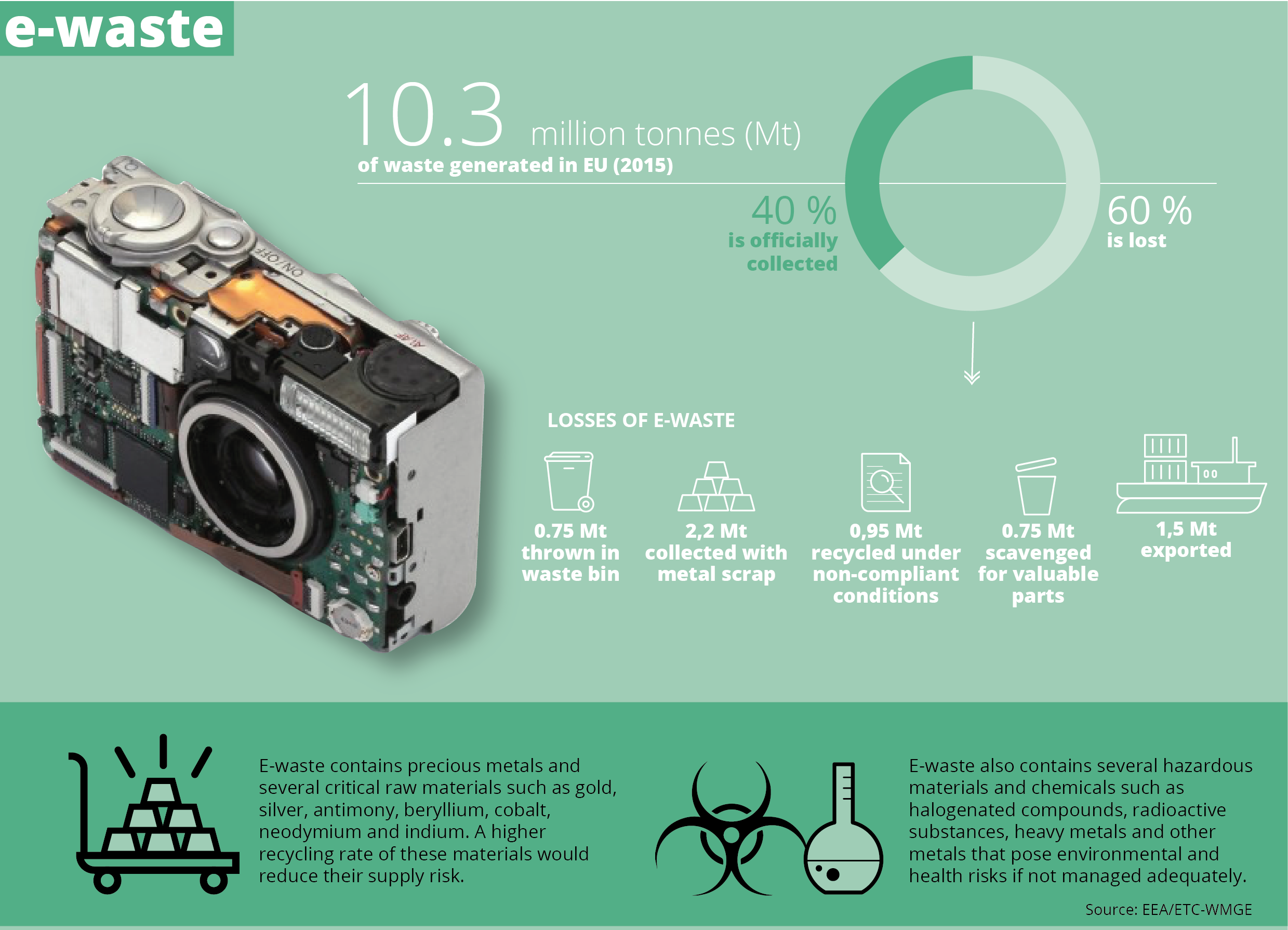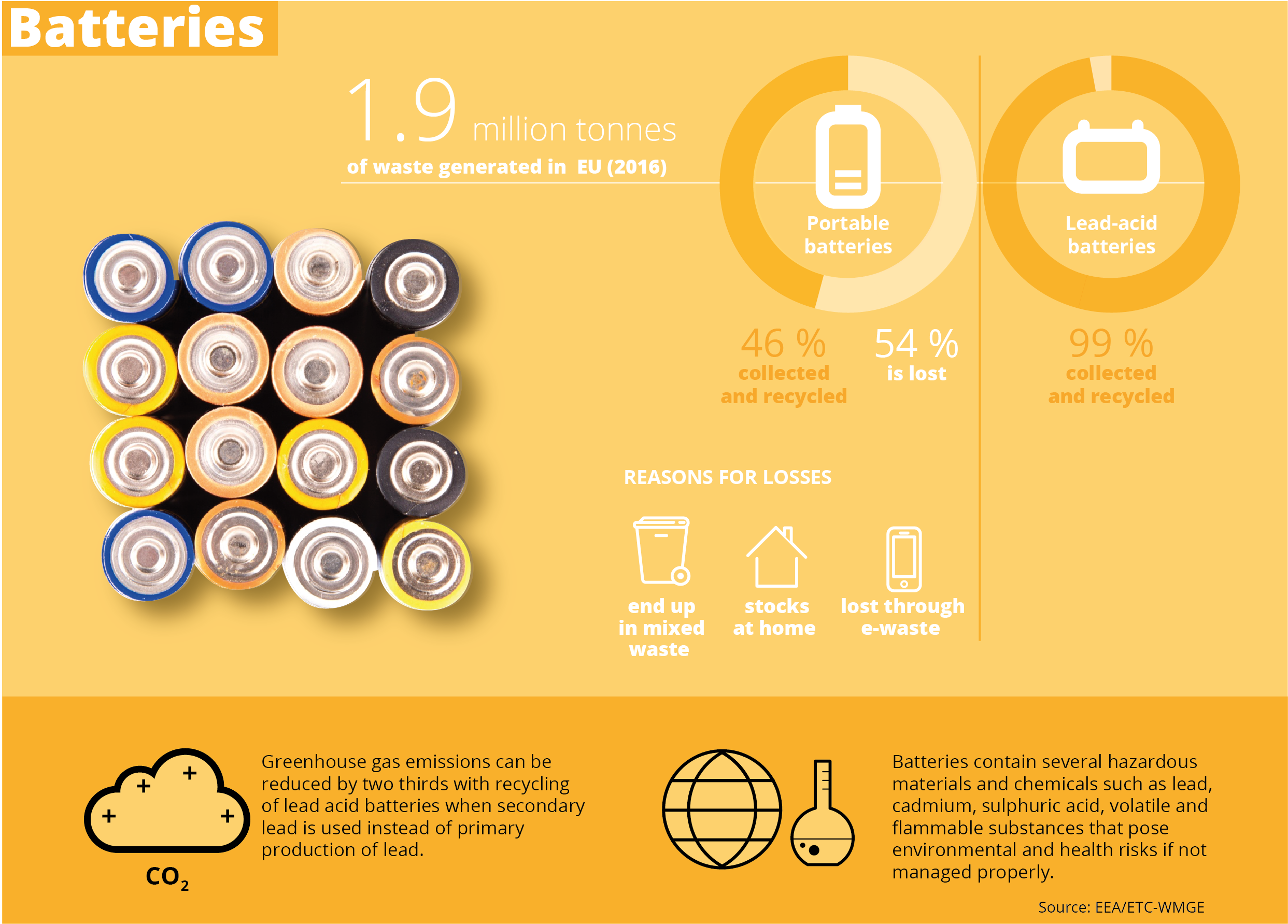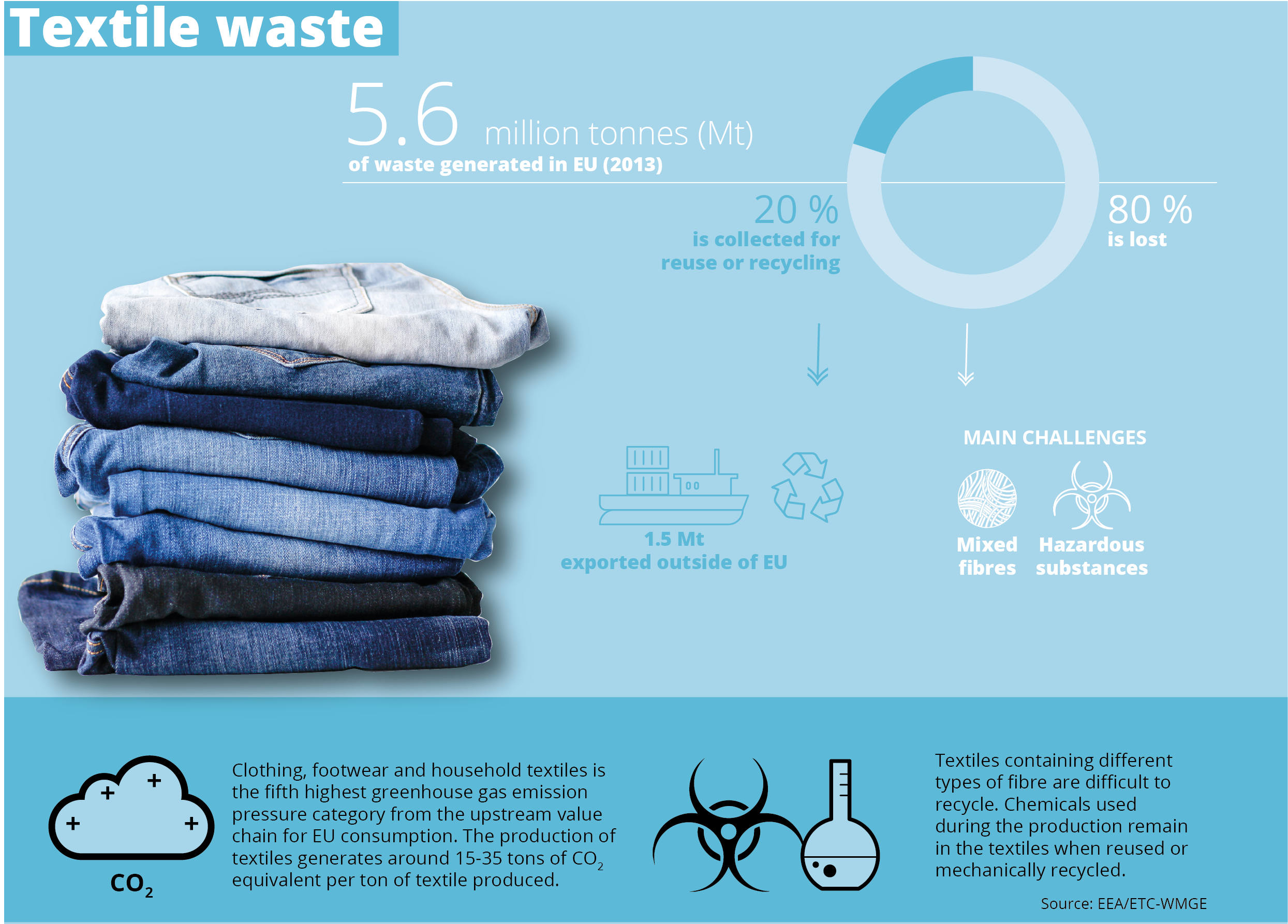Waste from electrical and electronic equipment
Technological change drives the continuous substitution of electrical and electronic equipment. The amount of waste (WEEE, also called e-waste) is steadily increasing and is one of the fastest growing waste streams in Europe. The amount of WEEE generated in Europe is over 10 million tonnes per year, roughly 40 % of which is currently collected for recycling (Huisman et al., 2017). The generation of WEEE is expected to increase in the future, and improvements in collection systems and awareness raising among consumers are needed to ensure increased recycling, leading to reduced losses.

WEEE contains precious metals and several critical raw materials that are fundamental to the functioning of key industrial sectors and applications. Although base metals such as ferrous metals, aluminium and copper from WEEE are already largely recycled, many critical raw materials or rare Earth elements cannot be effectively recovered because of low market prices that do not cover recycling costs, a lack of recycling technologies on a commercial scale or metallurgical limits to recovery processes (Thiébaud et al., 2018).
As WEEE also includes hazardous materials and chemicals that pose environmental and health risks, Directive 2011/65/EU of the European Parliament and of the Council of 8 June 2011 regulates the use of certain hazardous substances in electrical and electronic equipment. Although prohibited by EU legislation, cross-boundary transport of WEEE is known to take place between Europe and developing countries, where the environmental regulations are not as strict and labour costs are lower, creating additional environmental and health risks in these locations (Tansel, 2017).
Nonetheless, evidence exists that high-quality recycling can ensure the effective recovery of materials and energy from WEEE. A recent Norwegian study suggests that approximately 1 kg of CO2 equivalent is saved by the responsible recycling of a single mobile phone handset. By promoting the collection and recycling of mobile phones, Norway could save 2 000 tonnes of CO2 emissions each year (Baxter et al., 2016).
Many electrical and electronics products are not properly designed for recycling. Design choices that increase the marketability and durability of high-tech products create recycling challenges for separating components and material recovery. For example, miniaturisation and structurally integrated materials make disassembly and recovery more difficult. Although waste collection and waste management are key to reducing the loss of WEEE, more circular and recycling-friendly designs, supplies and manufacturing phases would result in longer product lifespans, modularity, standardisation of parts, easier remanufacturing, etc.
End-of-life batteries
Over 1.9 million tonnes of waste batteries are generated annually in Europe (Eurostat), and the amount is expected to increase in the future. Huge variations exist between different battery types in terms of their chemical composition and construction. Batteries contain a wide variety of materials, such as base metals, critical raw materials and hazardous substances. Therefore, collection and recycling rates, the profitability of recycling and impacts on the environment and health strongly depend on the battery type. The recovery of materials from waste batteries is driven by both waste policies and the economic value of the materials.
Lead-acid batteries account for a major share of all batteries placed in the market and collected as waste. Recycling of lead-acid batteries is well established, and it is estimated that 99 % of lead-acid batteries are collected for recycling (Eurobat, 2014). Because the process is relatively simple it is also profitable. The efficiency of recycling the lead content of lead-acid batteries is over 95 % in most EU countries. The use of secondary lead can reduce greenhouse gas emissions by two thirds compared with the primary production of lead (Stahl et al., 2018). Antimony, which is a critical raw material, is used as an additive in lead-acid batteries, and almost all of it is currently recovered and is the main source of secondary antimony (Dupont et al., 2016).
The average collection rate for portable batteries in the EU is much lower than that for lead-acid batteries at 46 % (Eurostat). A significant amount is therefore estimated to end up in municipal waste (35 kilotonnes per year). In particular, batteries embedded in electronic appliances often do not reach official collection points but are stored in consumers’ homes, exported outside the EU in used products or end up in WEEE recycling (Stahl et al., 2018). Although collection rates have increased continuously since 2009, substantial amounts of end-of-life batteries are still unreported.

In lithium-ion batteries, various active materials are used in thin coatings, which makes the recycling process more complicated and not very profitable. However, the lithium-ion battery sector is expected to grow in the near future, especially for industrial batteries and batteries used in electrical vehicles.
Textile waste
In Europe, more than 9.5 million tonnes of textiles are consumed annually, and the yearly disposal of textiles is estimated to be 5.6 million tonnes in total. More than 4 million tonnes of textile waste is not collected separately and generally ends up in mixed municipal solid waste, and 1.5 million tonnes of worn textiles are exported outside the EU.
Reliable and up-to-date data are limited for textile waste, and informal reuse (donation between family and friends) or reuse through second-hand shops is not included in waste statistics. Although there are some recent studies in several countries, there are no overall data for the EU as a whole on separate collection rates of textile waste. Based on a study of seven countries using data for 2014 or earlier, it was estimated that only 20 % of textiles are separately collected for reuse and recycling, and thus 80 % are lost (GFA & BCG 2017). Of the separately collected textiles, the reusable fraction is mainly exported and sold in foreign markets, while the non-reusable fraction is downcycled.
Mixed fibres and embedded hazardous substances make recycling difficult. Policymakers’ responses should include designing for circularity, easy material identification and improved collection systems.
The potential environmental gains that could be achieved through more extensive reuse or recycling are high: producing textiles is associated with significant environmental impacts, such as CO2 emissions, high water and land use, and chemical pollution, mainly caused by cotton production. As Europe is a net importer of textiles, the impacts avoided will mainly occur outside Europe.

The European Commission’s 2019 Report on the implementation of the circular economy action plan addresses the strengthening and extension of obligations for separate collection of textile waste by the end of 2025.
Plastic waste
Around 30 million tonnes of plastic waste is generated in the EU from almost all economic sectors. Of this, only 5 million tonnes are recycled in Europe and 25 million tonnes are lost, including misplaced waste and process losses in recycling (Material Economics, 2018). Nearly half of plastic packaging waste was exported outside Europe in 2015, mainly to China; lately, this has also included other countries in Asia (EC, 2018).
Presently, only part of the plastics collected can be reprocessed because of mixed streams, contamination and additive contents, which hamper recycling. Certain aspects of design and the presence of embedded hazardous and toxic substances make recycling technically and economically difficult. Furthermore, plastic waste is typically only recycled a few times because of material degradation, making downcycling (i.e. non-functional recycling) very common. Only 6 % of new plastic materials are derived from recycled plastics (EC, 2018), as plastic recyclables do not normally meet the material requirements for use in the same application.

The packaging sector is the single biggest contributor to plastic waste, generating around 16 million tonnes. This is followed by plastic waste from WEEE, the construction and demolition sector, and end-of-life vehicles. Packaging products — particularly single-use plastics — are typically used for a short time and quickly end up as waste.
Around 43 % of the plastic waste generated by the packaging sector in the EU-28 in 2016 was collected and the rest was disposed of in landfills or incinerated with energy recovery. Inadequate collection systems, together with the relatively low prices of virgin materials and high costs of sorting and processing (including investment costs), are the main challenges associated with the losses of plastic packaging waste.
In 2018, a European strategy for plastics in a circular economy was adopted. The strategy aims to transform the way plastics and plastic products are designed, produced, used and recycled. By 2030, all plastic packaging should be recyclable. In addition, the Single Use Plastics Directive requires measures to be taken to increase the collection of plastic bottles, the recycling of plastic packaging and the reduction of the consumption of plastic food containers.
Plastic products often also appear in paints, glues and binding agents in the construction sector, making recovery of plastic materials challenging and costly. The inclusion of plastic-containing components in building stock is considerable. Every year, about 1 million tonnes of plastic waste from construction is generated in Europe: among this plastic waste, PVC (polyvinyl chloride) has the highest recycling rate (32 %) (Plastics Europe, 2017). Technical challenges in recovering recyclable plastics from end-of-life vehicles and WEEE exist, and efforts dedicated to these waste streams mainly focus on metal recovery.
Conclusion
Poor or inadequate collection is a serious challenge that is linked to almost all of the waste streams analysed. Consumer awareness is another important factor in increasing the collection rates of different waste fractions. There are also various challenges related to the quality of waste materials, such as material heterogeneity and the presence of hazardous substances that hamper recycling.
For some materials, technological challenges are also important reasons for losses, as well as the lack of a market or demand for recyclables. The reasons for material losses are often cross-linked, e.g. waste quality (heterogeneity) and a lack of cost-efficient technology. More efforts are needed to introduce efficient systems for collecting and sorting waste. In addition, it is important to raise consumer awareness of how to achieve higher collection rates.
This briefing builds on the report Are we losing resources when managing Europe’s waste, compiled by the EEA and the European Topic Centre on Waste and Materials in a Green Economy (ETC/WMGE). For further details and underpinning references, please see the ETC Report.




Document Actions
Share with others